Playing through and breaking lines
This session is all about how my team look to break lines with forward runs, or well-weighted forward passes. I will look at various movements of players to be able to create the space to break lines centrally.

| Area | Up to two-thirds of a full-sized pitch |
| Equipment | Balls, bibs, x2 goals, x2 poles, x2 cones |
| No. of Players | Up to 15 players + 2 goalkeepers |
This session is all about how my team look to break lines with forward runs, or well-weighted forward passes. I will look at various movements of players to be able to create the space to break lines centrally.
We will focus on how we can find our players that drop into the pocket, and then from there look at the decision making of the player receiving the ball in the space. We focus on good ball speed to make the opposition move, creating gaps in defensive lines that will allow us to play through them.
We believe this session reinforces how we want to play. We look to build through each third of the pitch with a lot of emphasis on our number 10 or forwards dropping into the pocket to receive the ball in space.
The players enjoy this session because we focus on progressing forward, and we look at how we can receive the ball in between the lines. We will repeat this session but will introduce variations in movements. We will look at movements from the back three to join in the attack through overlaps and underlaps.
We will more than likely run this session in a week where we may be coming up against a side that would be expected to sit in a mid-to-low block against us. We will run the session then, as we need to think of various ways we can break through the defensive lines.
“The players enjoy this session because we focus on progressing forward, and we look at how we can receive the ball in between the lines”
Passing pattern
We set up an area 30 yards long and 20 yards wide, with two cones indicating width and two poles indicating length [1a].
[1a]
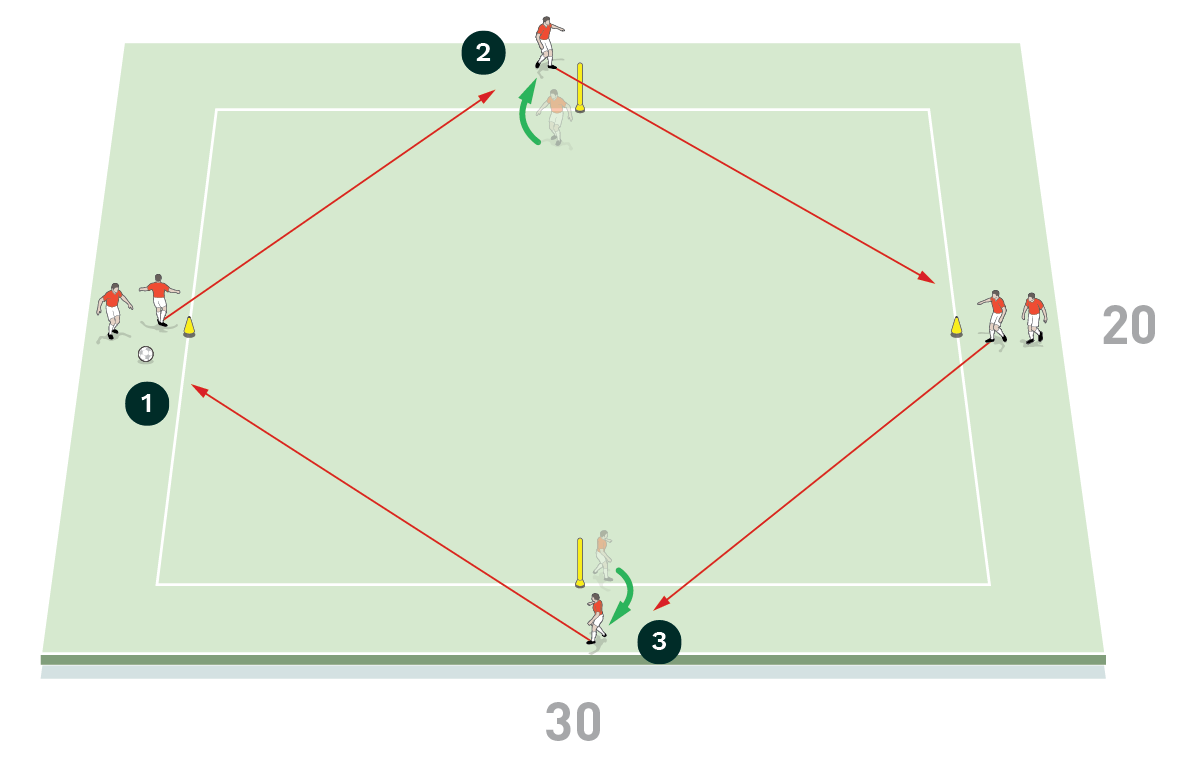
-
The ball starts with one of the players, who plays the ball to the inside player
- The player takes a touch to turn, and then plays the ball to the other wide player
- The ball continues around the circuit in this pattern
Six players are used, with two behind each cone and one behind each pole. The ball will start with one of the players at the left cone. They will then play the ball to a player based at one of the poles, who is expected to take a touch to turn and then play to the other wide player at the right-hand cone. They then do the same, passing to the player at the other pole. The ball will then continue around the circuit in this pattern, with the players at the cones interchanging.
Using the same dimensions, the next exercise begins again with one of the players at the left cone [1b].
[1b]
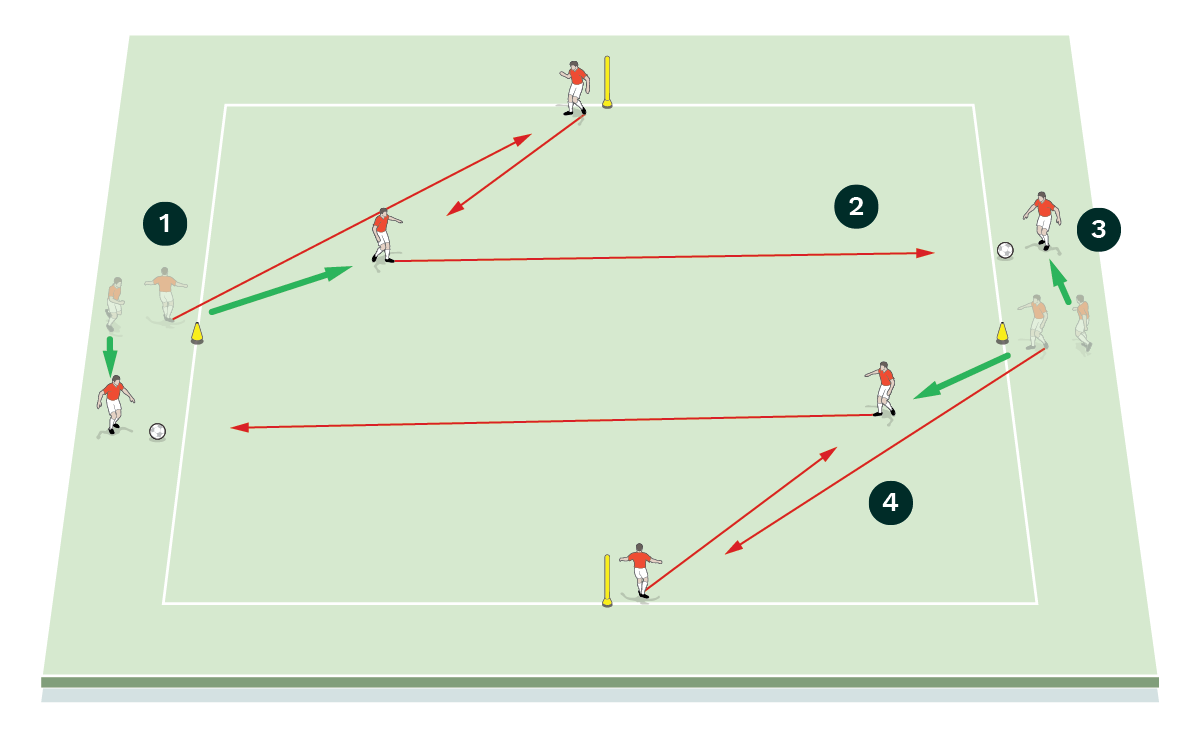
-
The ball starts here, with the player looking to play a one-two with the central player
- They then play the ball through to the other side of the pitch
- A second ball is now used to start the pattern from this side of the pitch
- Play continues around the circuit in this pattern
They are expected to play a one-two with one of the central pole players. They then play the ball through to the other side of the playing area to the right-hand cone player. A second ball is then used to begin the pattern from the right cone. Play is expected to continue around the circuit in this pattern with two balls in play.
The next play begins in the same way (on the left) in the same area, with the player passing the ball to the central player before running beyond them to create an overlap [1c].
[1c]
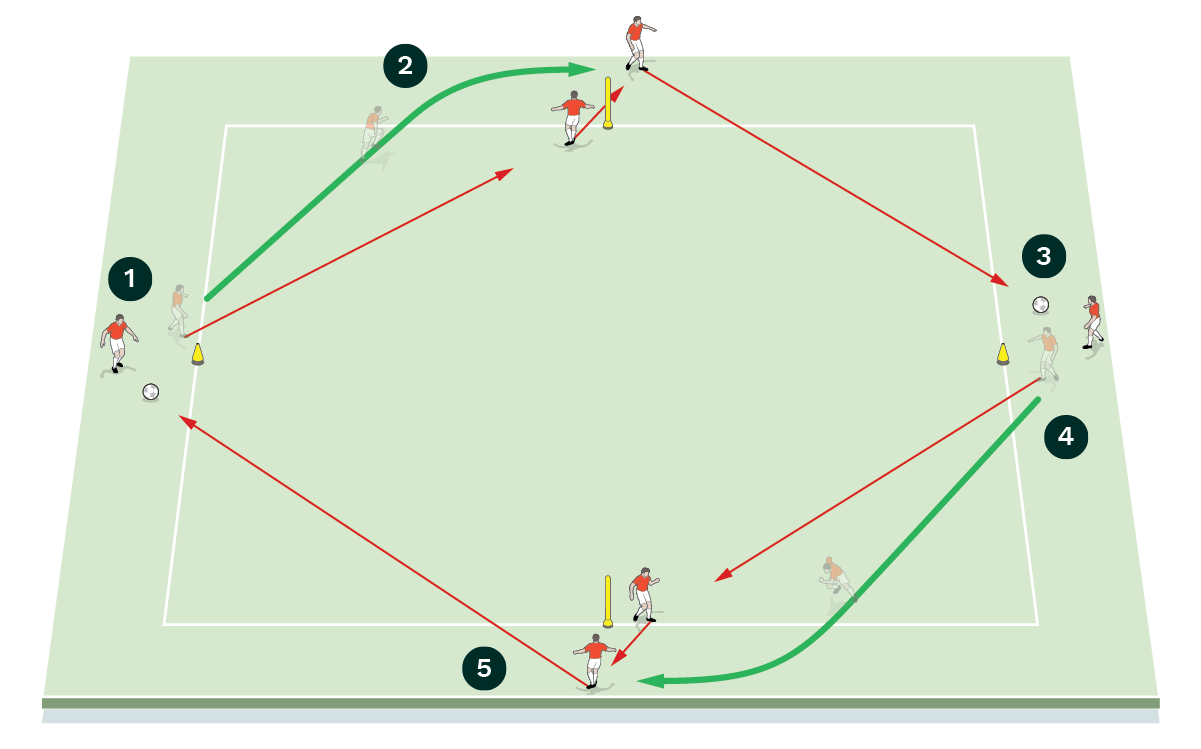
-
The ball starts with one of the players on the left
- The player plays the ball to the central player and overlaps
- They then play the ball wide
- A second ball is then used to start the pattern from the other side
- The ball continues around the circuit in this pattern
The central player is then expected to feed the player out wide. A second ball is then introduced from the right cone player, again, continuing the circuit in this pattern.
Main session
Two-thirds of a full-sized pitch are used for the next exercise, with a second 18-yard box created from the halfway line. There are full size goals and a goalkeeper at each end, with a goalkeeper in each. The middle area of the pitch runs from both ends of the 18-yard boxes, length and width [2a] – and is split into four lanes.
[2a]
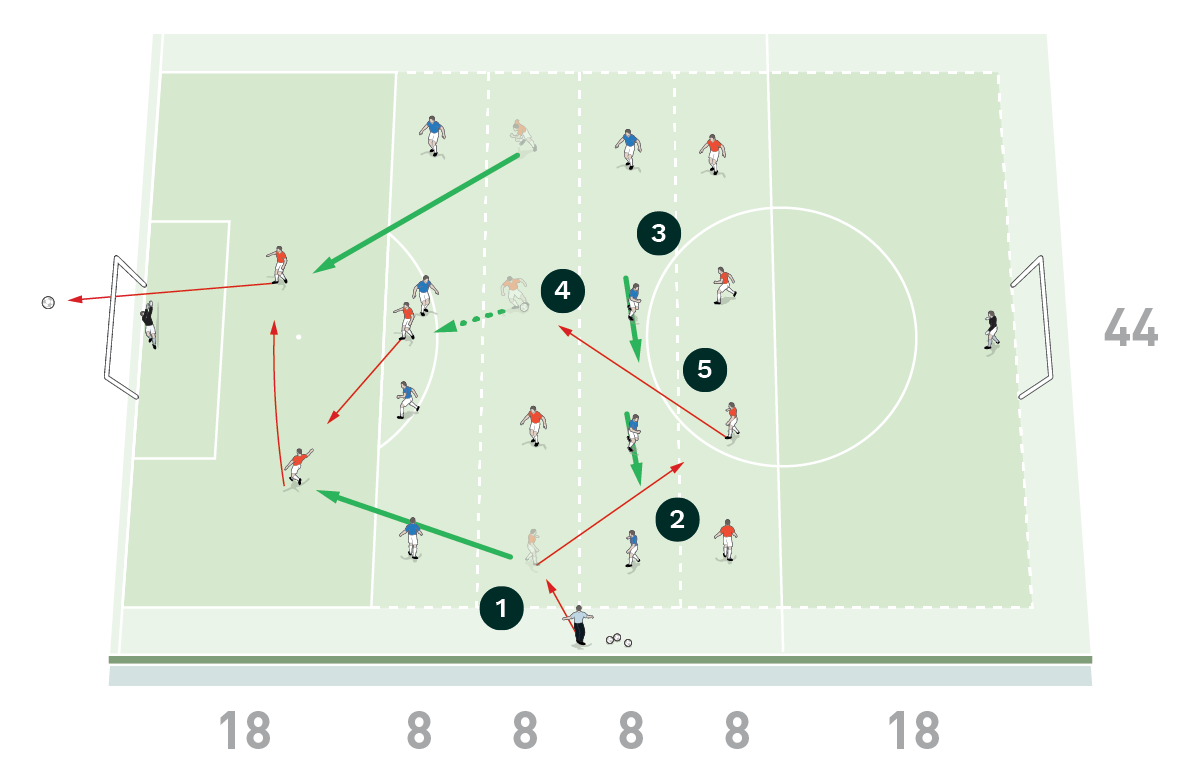
-
The coach starts play by playing the ball into the middle
- The middle four must play back to their defensive four as quickly as possible
- The defensive four must then play the ball back to the middle four
- The middle four can then turn and attack the opposition defensive four
- The defending team are locked into their zone and can’t jump out to press, they must slide and screen and look to intercept passes
Sixteen players will be used, split into two teams (blues v reds), with two groups of four each stationed sequentially across a different lane. A coach will be stationed to one side of the middle area, and will begin play by passing the ball into the reds’ middle area. The idea is for the middle four to play the ball back to their defensive four as quickly as possible. The defensive four should then play the ball back to the middle four. They are then expected to turn and attack the opposition’s defensive four. The defending team must stay in their zone and can’t leave that area to press, looking to slide and screen, aiming to intercept passes.
The set-up remains the same, with the coach starting play again, this time playing the ball to the blue team [2b].
[2b]

-
The coach starts the play again, this time playing the ball to the blue team
- If the defending team win the ball back, they can then attack
If the defending team win the ball back, they can then attack. As a progression to the exercise, one of the defending midfielders can jump out of their zone to press one of the players in possession in the back four [2c].
[2c]
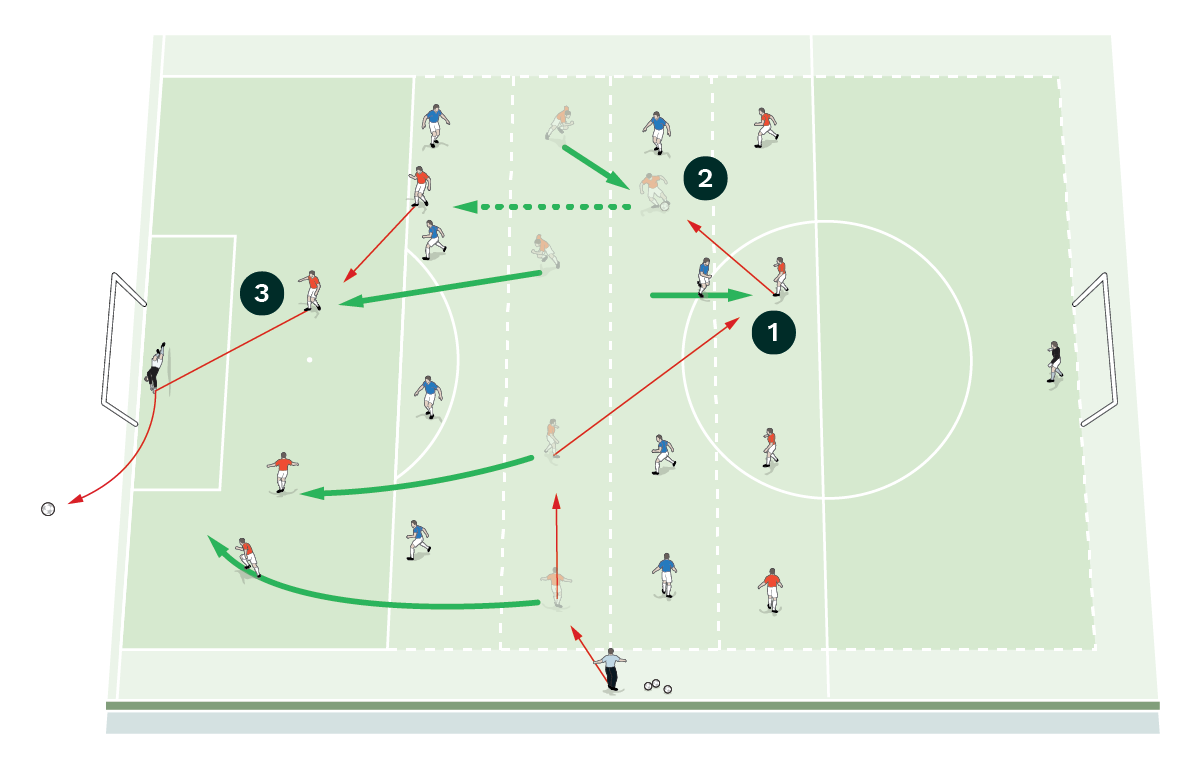
-
One of the defending midfielders can leave their zone to press one of the in-possession back four
- When the back four has the ball, one of the in-possession midfield players must drop into the opposition midfield zone to receive the ball
- Once the midfielder receives the ball, they should look to drive forward towards goal, or combine with their team-mates to get quick shots off
When the back four has the ball, one of the in-possession midfield players must drop into the opposition midfield zone to receive the ball. Once this midfield player receives the ball, they should look to drive forward towards the goal or combine with their team-mates to get quick shots off.
Three-team game
Half a full-sized pitch is used, with a second 18-yard box marked out from the halfway line – with the width of the boxes used [3a].
[3a]

-
The red and blue teams work together to keep the ball – they can only play along the ground and aren’t allowed to play lofted passes
- Three players from the yellow team press the side with the ball, the remaining two yellow players slide and screen
- One player from the opposite side can drop into the central area to receive the ball
- Once a player receives in the central zone they must turn and play into their own colour before trying to play back into the other side
A five-yard channel is also marked out across the middle of the pitch. Two full size goals are at either end, with a goalkeeper at each.
Fifteen outfield players are to be used, split into three teams of five (reds, blues and yellows) – with each team spread across each of the three areas. The aim is for the red and blue teams – at either end – to work together to keep the ball. In this instance, the ball will start with the red players. They can only play the ball along the ground and aren’t allowed to play any lofted passes.
Three players from the yellow team in the middle five will attempt to press the side with the ball, with the remaining two yellow players sliding and screening. One player from the opposite (blue) side can drop into the central area to receive the ball. Once they receive the ball in this zone they must turn and play back into their own team (blues) before trying to play the ball back to the other side of the pitch (to the red team).
When the pressing team (yellows) win the ball, they look to score in the goal they are facing as quickly as they can [3b].
“The aim is for the red and blue teams - at either end - to work together to keep the ball”
[3b]

-
The pressing team win the ball
- They look to score in the goal they are facing as quickly as they can
As a progression, the central team (yellows) can decide how many players they press with [3c].
[3c]
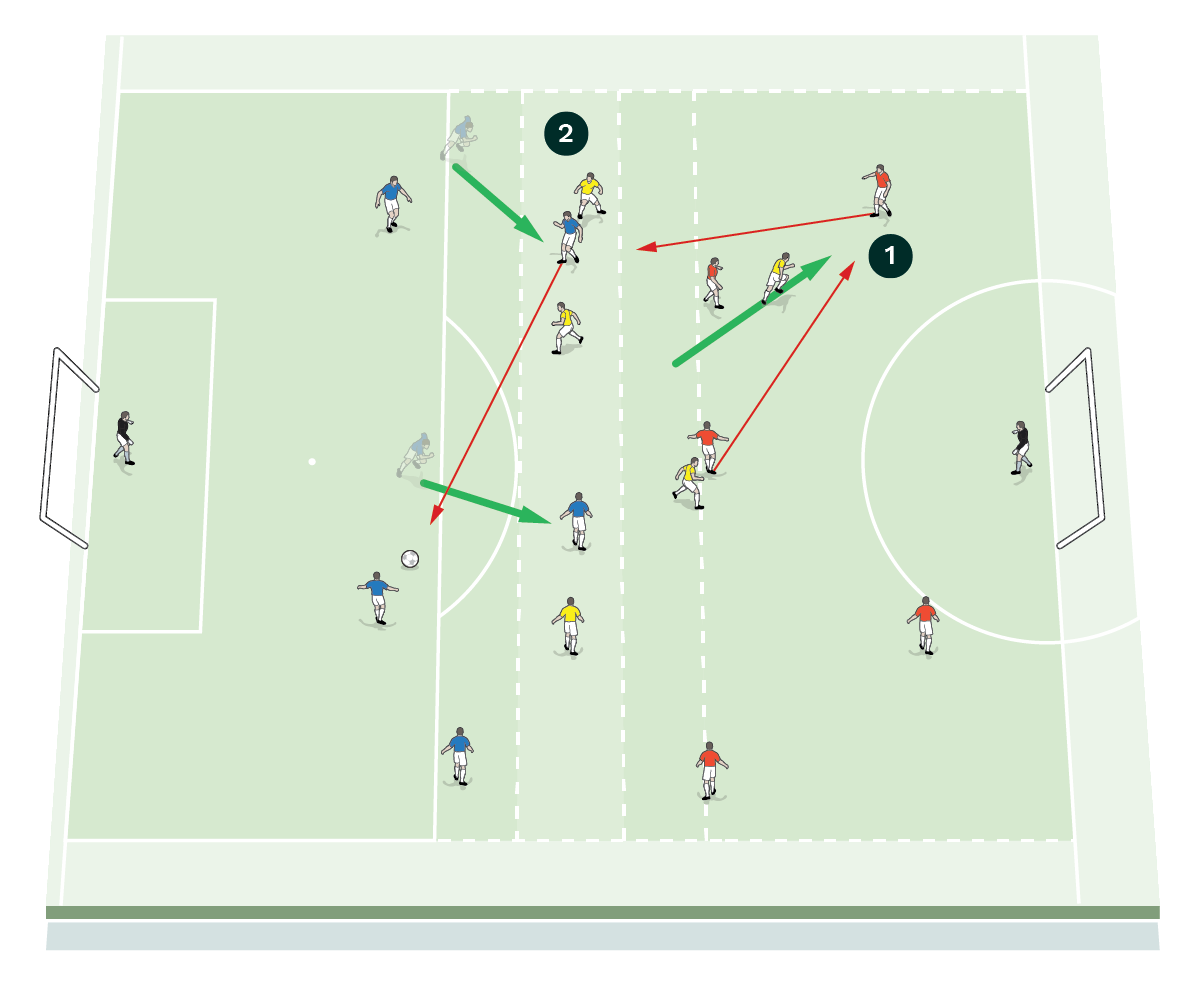
-
The central team can decide how many players they press with
- The team dropping can drop into the zone with two players or more
The team dropping can choose to move into the zone with two players or more.
COACHING POINTS
What are the key things to look for?
Players taking a good forward touch out of their feet, and players scanning the pitch before they have received the ball.
I am looking for my attacking players to time their runs into the pocket, to make sure they can receive the ball in space with an open body, to enable them to play forward quickly.
If a player receives the ball with their back to goal and under pressure, can they manipulate the ball away from the defender to turn and play?
I want players in possession to deliver well-weighted passes along the floor to break lines, and focus on the detail of the pass, such as which foot – and side of the player – they are passing to.
From forward passes, I am looking at players making good forward runs to break lines and runs into deeper areas to force defensive lines back.
I am looking for my players to play under pressure and be confident and comfortable when under pressure from a defender.
What are the typical mistakes players might make and how do I avoid them?
Players will look to, at times, force balls through gaps that aren’t there. The risk is loss of possession and a counter-attack from the opposition.
I encourage my players to move the ball across – or forward – and then bounce back to open the gaps centrally. I want my players that aren’t in possession to scan and look forward, so they can play the ball quicker.
Some players are reluctant to play passes to marked team-mates. I encourage my players to receive the ball under pressure in training. I want them to be able to feel where the defender is and to manipulate the ball away from them. I encourage my players to play to marked players that ask for the ball.
At times there is a fear of losing possession if we play to someone that is marked. But to encourage and promote creativity, we must put trust into those players that demand the ball, even under pressure.
Editor's Picks
Attacking transitions
Deep runs in the final third
Using the goalkeeper in build-up play
Intensive boxes drill with goals
Penetrating the final third
Creating and finishing
My philosophy
Pressing initiation
Compact team movement
Coaches' Testimonials

Alan Pardew

Arsène Wenger

Brendan Rodgers

Carlos Carvalhal

José Mourinho

Jürgen Klopp

Pep Guardiola

Roy Hodgson

Sir Alex Ferguson

Steven Gerrard
Coaches' Testimonials

Gerald Kearney, Downtown Las Vegas Soccer Club

Paul Butler, Florida, USA

Rick Shields, Springboro, USA

Tony Green, Pierrefonds Titans, Quebec, Canada
Join the world's leading coaches and managers and discover for yourself one of the best kept secrets in coaching. No other training tool on the planet is written or read by the calibre of names you’ll find in Elite Soccer.
In a recent survey 92% of subscribers said Elite Soccer makes them more confident, 89% said it makes them a more effective coach and 91% said it makes them more inspired.
Get Monthly Inspiration
All the latest techniques and approaches
Since 2010 Elite Soccer has given subscribers exclusive insight into the training ground practices of the world’s best coaches. Published in partnership with the League Managers Association we have unparalleled access to the leading lights in the English leagues, as well as a host of international managers.
Elite Soccer exclusively features sessions written by the coaches themselves. There are no observed sessions and no sessions “in the style of”, just first-hand advice delivered direct to you from the coach.





